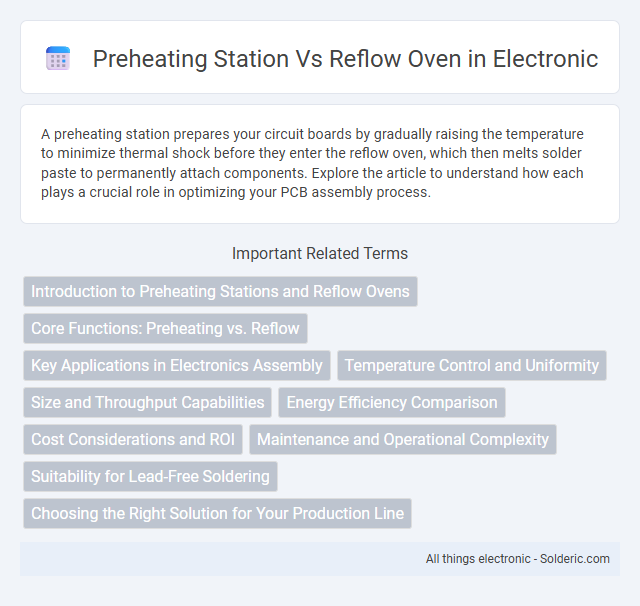A preheating station prepares your circuit boards by gradually raising the temperature to minimize thermal shock before they enter the reflow oven, which then melts solder paste to permanently attach components. Explore the article to understand how each plays a crucial role in optimizing your PCB assembly process.
Comparison Table
| Feature | Preheating Station | Reflow Oven |
|---|---|---|
| Purpose | Gradually heats PCBs before soldering | Melts solder paste for component placement |
| Temperature Control | Lower, steady temperature (typically 100-150degC) | Precise multi-zone temperature profile up to 250degC+ |
| Heating Method | Convection or infrared heating | Convection, infrared, or vapor phase heating |
| Application | Prepares PCB to reduce thermal shock | Soldering surface-mount devices (SMDs) |
| Process Time | Short preheat cycles (minutes) | Complete reflow cycles (around 5-10 minutes) |
| Typical Use Case | Small volume or manual assembly | Automated, high-volume PCB assembly |
| Cost | Lower initial investment | Higher cost due to complex controls |
| Advantages | Reduces PCB warping, thermal stress | Consistent solder joints, high throughput |
| Limitations | Not suitable for full soldering process | Requires more space and maintenance |
Introduction to Preheating Stations and Reflow Ovens
Preheating stations provide controlled, gradual temperature increases to solder components on printed circuit boards, reducing thermal shock and improving solder joint reliability. Reflow ovens use precise heating zones to melt solder paste uniformly, ensuring consistent soldering quality across complex assemblies. Both technologies play crucial roles in surface mount technology (SMT) manufacturing processes, optimizing thermal profiles for effective component bonding.
Core Functions: Preheating vs. Reflow
A preheating station raises the temperature of printed circuit boards (PCBs) gradually to prepare them for soldering by preventing thermal shock and ensuring uniform heat distribution. In contrast, a reflow oven precisely melts solder paste to form reliable electrical and mechanical connections through controlled heating profiles that include preheating, soaking, and reflow phases. The core function of the preheating station is temperature stabilization, while the reflow oven executes solder reflow, combining heat profiles critical for high-quality surface mount technology (SMT) assembly.
Key Applications in Electronics Assembly
Preheating stations and reflow ovens play critical roles in electronics assembly, particularly in surface mount technology (SMT) processes. Preheating stations are mainly utilized to gradually raise the temperature of printed circuit boards (PCBs) to prevent thermal shock and ensure uniform solder paste activation before the reflow process. Reflow ovens are essential for melting solder paste and permanently attaching surface mount components to PCBs through controlled temperature profiles, enhancing solder joint reliability and overall assembly quality.
Temperature Control and Uniformity
Preheating stations provide localized temperature control with steady heat distribution, ideal for preparing components before soldering. Reflow ovens offer precise temperature profiling over multiple zones, ensuring uniform heating across the entire PCB for consistent solder joint quality. Your choice depends on the need for uniform thermal exposure and the complexity of the assembly process.
Size and Throughput Capabilities
Preheating stations typically have a compact footprint suitable for small to medium-sized PCB assemblies, offering moderate throughput ideal for batch processing or prototypes. Reflow ovens are larger, designed for high-volume production lines, enabling continuous processing with significantly higher throughput capabilities. The choice between the two depends on production scale, with reflow ovens maximizing efficiency in mass production environments.
Energy Efficiency Comparison
Preheating stations consume less energy by rapidly bringing components to target temperatures before soldering, reducing thermal losses compared to reflow ovens that maintain elevated temperatures over larger volumes. Reflow ovens, while precise for complex PCB assemblies, use continuous energy input over extended cycles, which can result in higher overall power consumption. Choosing a preheating station can lower your operational energy footprint without compromising soldering quality for simpler applications.
Cost Considerations and ROI
Preheating stations generally offer lower initial costs and reduced energy consumption compared to reflow ovens, making them a budget-friendly choice for small-scale or selective soldering tasks. Reflow ovens, while requiring higher upfront investment, provide greater throughput and consistency, leading to improved yield rates and faster return on investment (ROI) in high-volume production environments. Evaluating your production scale and quality requirements will help determine whether the cost savings of a preheating station or the efficiency gains of a reflow oven deliver better long-term ROI.
Maintenance and Operational Complexity
Preheating stations require less maintenance due to their simpler design and lower temperature range, resulting in reduced downtime and operational costs. Reflow ovens involve more complex maintenance routines, including regular calibration, conveyor belt adjustments, and inspection of heating elements to ensure consistent temperature profiles. Operational complexity is higher in reflow ovens as they manage precise thermal cycles across multiple zones, demanding skilled technicians for optimal performance.
Suitability for Lead-Free Soldering
Preheating stations provide precise temperature control essential for lead-free soldering, reducing thermal shock and ensuring uniform PCB heating before reflow. Reflow ovens offer consistent, programmable profiles that accommodate the higher melting points of lead-free solders, improving joint quality and reducing defects. Your lead-free soldering process benefits from the combination of preheating stations and reflow ovens to achieve optimal thermal management and reliable solder joints.
Choosing the Right Solution for Your Production Line
Preheating stations stabilize PCB temperature gradually to prevent thermal shock, making them ideal for sensitive components and low to medium volume production. Reflow ovens provide efficient, uniform heating with precise temperature control, suited for high-volume manufacturing and complex multi-layer assemblies. You should choose based on component sensitivity, production scale, and desired throughput to optimize soldering quality and process reliability.
preheating station vs reflow oven Infographic

 solderic.com
solderic.com